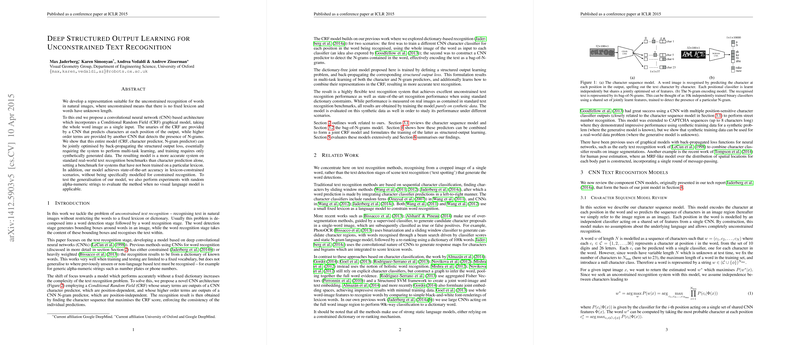Deep Structured Output Learning for Unconstrained Text Recognition: An Overview
The authors of the paper present a novel approach to unconstrained text recognition utilizing deep structured output learning. The primary objective is to recognize text in natural images without relying on a fixed lexicon, addressing the challenges posed by variable word lengths and diverse character sequences.
Architectural Innovation
At the heart of the proposed solution is an architecture that uses Convolutional Neural Networks (CNNs) combined with a Conditional Random Field (CRF). This framework allows the model to treat the entire word image as a single input, producing robust predictions. The CRF incorporates two main components: a character predictor and an N-gram predictor. The character predictor derives position-dependent unary scores through CNNs, while the N-gram predictor, also a CNN, provides higher-order terms that are position-independent.
The end-to-end model engages in multi-task learning, leveraging synthetically generated data for training. This strategy demonstrates a salient advantage over conventional text recognition methods that heavily depend on constrained lexicons.
Numerical Performance and Benchmarks
The authors assess their model on various benchmarking datasets such as ICDAR 2003, ICDAR 2013, Street View Text, and IIIT5k. The model achieves state-of-the-art recognition accuracy in both constrained and unconstrained scenarios. Particularly noteworthy is its ability to outperform methods that utilize strong static LLMs or dictionaries by effectively generalizing from synthetic training data.
Several experiments underscore the model's prowess:
- ICDAR 2003: The proposed joint model delivered an accuracy boost of approximately 4% over the character prediction baseline.
- Synthetic Data: The model maintained high accuracy when trained on synthetic data or completely random sequences, underscoring its generalization capabilities.
Theoretical and Practical Implications
The structure of the CRF framework, which allows for joint optimization of character and N-gram scores via backpropagation, positions this model as a significant advancement in text recognition. The paper's methodological contribution lies in its ability to generalize beyond seen data, making it particularly useful for applications needing recognition of rare or custom text sequences, such as vehicle license plates or user-generated alphanumeric codes.
Theoretically, the use of structured output learning introduces more nuanced relationships between character sequences and contextual N-grams, improving the model's ability to interpret visual text cues more accurately. Practically, this flexibility is essential for real-world applications, where lexicon-independent recognition can circumvent the limitations posed by static LLMs.
Future Directions
While the paper presents strong results, further exploration could enhance the method's applicability and efficiency. Future research may consider:
- Refinements to N-gram selection and scoring to enhance recognition accuracy for highly variable text sequences.
- Extensions to accommodate multilingual text recognition scenarios, increasing the model's global applicability.
- Investigations into optimizing the efficiency of joint CRF-CNN architectures for deployment in resource-constrained environments, such as mobile devices.
In summary, the paper delivers a robust approach to unconstrained text recognition through a sophisticated integration of CNNs and CRFs, highlighting its capability to generalize across diverse datasets and settings. This work lays foundational principles for future innovations in the field of text recognition and broader computer vision applications.
